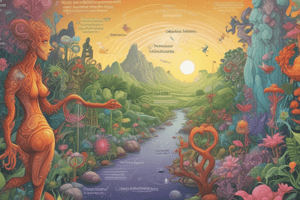Podcast
Questions and Answers
Which of the following is NOT a key ecological concept?
Which of the following is NOT a key ecological concept?
- Population dynamics
- Natural selection (correct)
- Cycling of nutrients
- Energy flow through ecosystems
What is a major threat to biodiversity?
What is a major threat to biodiversity?
- Stable climate conditions
- Introduction of invasive species (correct)
- Increased habitat availability
- Reduced pollution levels
Which of these is NOT a major taxonomic group?
Which of these is NOT a major taxonomic group?
- Domains
- Phyla
- Families
- Communities (correct)
What is the primary driver of evolution according to natural selection?
What is the primary driver of evolution according to natural selection?
What is the relationship between ecology and biodiversity?
What is the relationship between ecology and biodiversity?
Which of the following processes is NOT essential for maintaining the stable internal environment of an organism?
Which of the following processes is NOT essential for maintaining the stable internal environment of an organism?
Which of the following is NOT a key characteristic of life?
Which of the following is NOT a key characteristic of life?
What is the primary function of photosynthesis?
What is the primary function of photosynthesis?
Which of the following levels of biological organization is characterized by a group of interacting populations of different species?
Which of the following levels of biological organization is characterized by a group of interacting populations of different species?
Which of the following is a characteristic of prokaryotic cells?
Which of the following is a characteristic of prokaryotic cells?
What is the role of DNA in genetics?
What is the role of DNA in genetics?
Which of the following is an example of a branch of biology that studies the interactions between organisms and their environment?
Which of the following is an example of a branch of biology that studies the interactions between organisms and their environment?
What is the main difference between a gene and a protein?
What is the main difference between a gene and a protein?
Flashcards
Biology
Biology
The scientific study of life and living organisms.
Key Characteristics of Life
Key Characteristics of Life
Characteristics distinguishing living organisms: cellular organization, metabolism, growth, response to stimuli, reproduction, adaptation, homeostasis.
Cellular Organization
Cellular Organization
All living things are composed of cells, the basic units of life.
Metabolism
Metabolism
Signup and view all the flashcards
Cell Types
Cell Types
Signup and view all the flashcards
Genetics
Genetics
Signup and view all the flashcards
DNA
DNA
Signup and view all the flashcards
Homeostasis
Homeostasis
Signup and view all the flashcards
Evolution
Evolution
Signup and view all the flashcards
Natural Selection
Natural Selection
Signup and view all the flashcards
Biodiversity
Biodiversity
Signup and view all the flashcards
Classification of Organisms
Classification of Organisms
Signup and view all the flashcards
Study Notes
Introduction to Biology
- Biology is the scientific study of life and living organisms, including their structure, function, growth, origin, evolution, distribution, and taxonomy.
- It encompasses a vast range of disciplines, including:
- Botany (plants)
- Zoology (animals)
- Microbiology (microorganisms)
- Ecology (organisms and their environment)
- Genetics (heredity)
- Physiology (function of organisms)
- Molecular biology (molecular basis of life)
Key Characteristics of Life
- Organisms exhibit key characteristics distinguishing them from non-living matter:
- Cellular organization: All living things are composed of cells, the basic units of life.
- Metabolism: Organisms take in and use energy for maintenance, growth, and reproduction.
- Growth and Development: Living things increase in size and complexity over time, following specific patterns.
- Response to stimuli: Living organisms react to changes in their environment.
- Reproduction: Organisms produce new individuals of the same kind.
- Adaptation: Organisms evolve to become better suited to their environments over generations.
- Homeostasis: Maintaining a stable internal environment.
Biological Organization
- Organisms are organized hierarchically, starting with atoms and molecules forming macromolecules.
- Levels of organization include molecules, cells, tissues, organs, organ systems, organisms, populations, communities, ecosystems, and biosphere.
Cellular Biology
- Cells are the fundamental units of life, exhibiting great diversity in structure and function.
- Cells are broadly classified into prokaryotic (lacking a nucleus) and eukaryotic (possessing a nucleus and other membrane-bound organelles).
- Key cellular processes include:
- Respiration, releasing energy from food.
- Photosynthesis, converting light energy into chemical energy in plants.
- Cell division, for growth and repair.
- Protein synthesis, essential for cellular function.
Genetics
- Genetics focuses on heredity and the transmission of traits across generations.
- DNA (deoxyribonucleic acid) is the molecule carrying genetic information.
- Genes are segments of DNA coding for specific proteins.
- Gene expression is the process using gene information to synthesize a functional gene product.
- Mutations introduce changes in DNA, potentially causing different traits.
Evolution
- Evolution is the process where populations of organisms change over time.
- Natural selection is a key mechanism of evolution, favoring organisms with advantageous traits for survival and reproduction.
- The theory of evolution explains the diversity and unity of life on Earth.
Ecology
- Ecology studies interactions between organisms and their environment.
- Ecosystems encompass all living (biotic) and non-living (abiotic) components in a specific area.
- Key ecological concepts include:
- Energy flow through ecosystems.
- Nutrient cycling.
- Biodiversity.
- Population dynamics.
- Community interactions (predation, competition, symbiosis).
Biodiversity
- Biodiversity refers to the variety of life on Earth at all levels, from genes to ecosystems.
- High biodiversity is crucial for healthy ecosystems and ecosystem services.
- Threats to biodiversity include habitat loss, pollution, climate change, and invasive species.
Classification of Organisms
- Organisms are classified into groups based on shared characteristics, using a hierarchical system.
- Major taxonomic groups include domains (Bacteria, Archaea, Eukarya), kingdoms, phyla, classes, orders, families, genera, and species.
- Understanding classification helps to organize and understand the vast diversity of life on Earth.
Studying That Suits You
Use AI to generate personalized quizzes and flashcards to suit your learning preferences.




